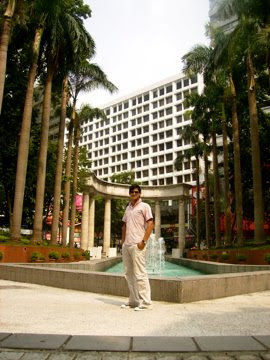 0
comments
22 September 2008
0
comments
22 September 2008
On the 15th of September, I took the ferry to Macao, an island in front of the coast of China where the Portuguese in the 15th century first went on shore: Vasco de Gama visited the peninsula in 1497. My visit 511 years later felt as a ‘must,’ considering the rich history of the island and the fact that the island was an early ‘contact zone’ for east and west. Of course Macao has changed a lot since Matteo Ricci and Francis Xavier walked around, yet the churches, missionary buildings, and crucifixes reminds of its Christian and Portuguese past. Ironically though, Macao has now turned into the Las Vegas of the east, because it’s one of the few places where gambling is not forbidden. Huge casino’s light up at night; dramatically overdone, but surely gives a nice view from the 68th floor in the Macao tower.
(Ruins of St Paul Church)
To talk about an other museum: the Macao Museum in the centre is most definitely worth a visit, because it’s shows a historical and comparative story of China and Europe, under the title of “Continuous Convergence.” I have yet to find a more suitable application of our master programme in a museum. You walk through an alley, and on your left you see the history of Europe and on your right the Chinese. You could choose just to see the one or the other, but you’re invited to make the comparison yourself. First, examples of the Egyptian, Persian, Hebrew, Greek, and Latin scripts are compared with the evolutionary development of the Chinese script. Second, the Roman empire and Qin empire (first emperor Qin Shihuang and his terracotta army) are shown with their accomplishments. Further comparisons concern schools of thought (Greek philosophers and Confucius), religions (Christianity, Buddhism, Taoism), science and technology, and it keeps on going; as long as it fits in the idea of east and west convergence.
In the museum, the number of houses were rebuild to give an impression of a Macao street through time. The first house is typical Chinese, the last typical Portuguese, and the houses in between combinations of the two. A map of the world show the Portuguese trade routs over the oceans as well as the famous Silk Road through Central Asia towards the west. This comparison technique is practised on practically everything: Chinese and Christian marriage rituals, eastern and western medicine, a Chinese and a Portuguese living-room, which contained a picture of a Portuguese-Chinese couple and their children. The story is at times a bit too romantic, yet very entertaining and interesting.
I couldn’t thus detect any clashes between the Chinese and Portuguese. One violent confrontation is mentioned, which only gave the Macao and the Portuguese a common enemy: the Dutch! It turns out that the Dutch tried to take over control over Macao, and although initially successful, they were defeated by Portuguese soldiers and Macao civilians. Since 1999, Macao passed to China, but is considered a Special Administrative Region so I have an extra stamp in my passport!
[Pictures soon]







